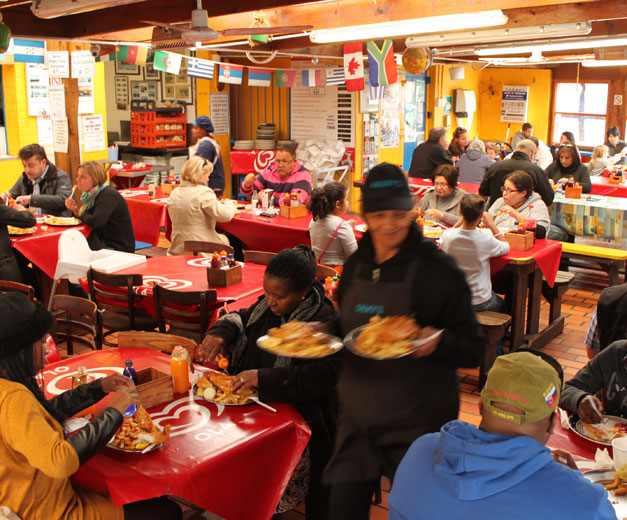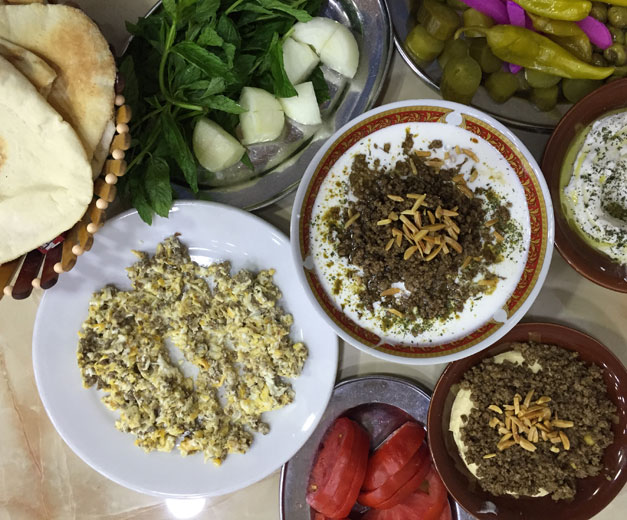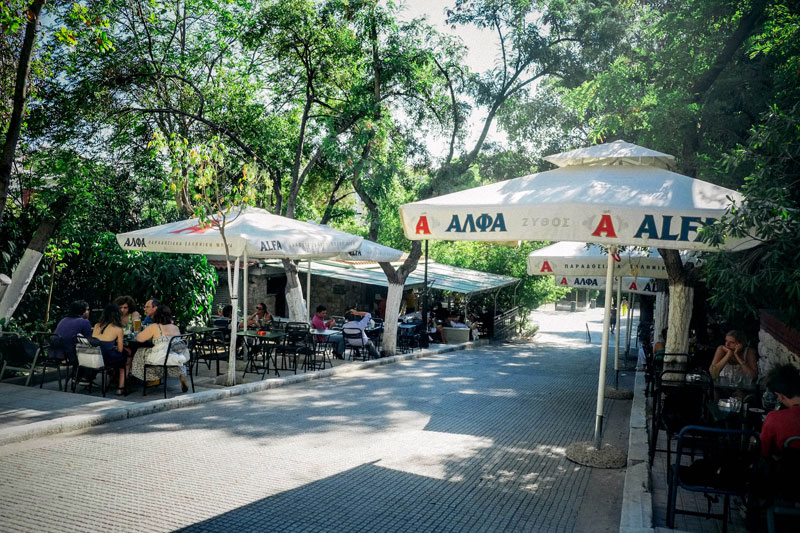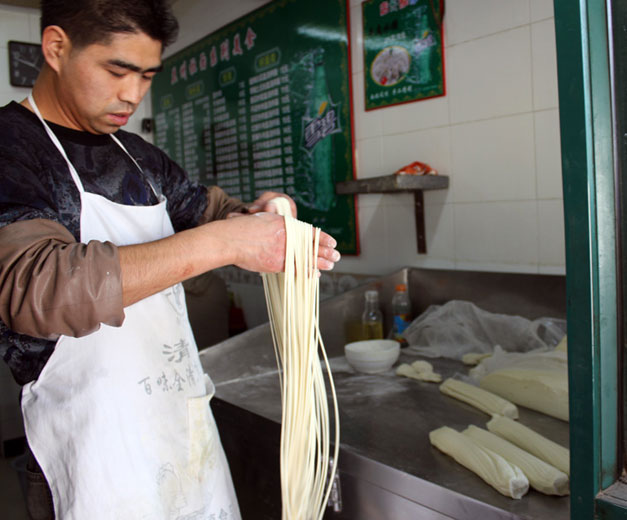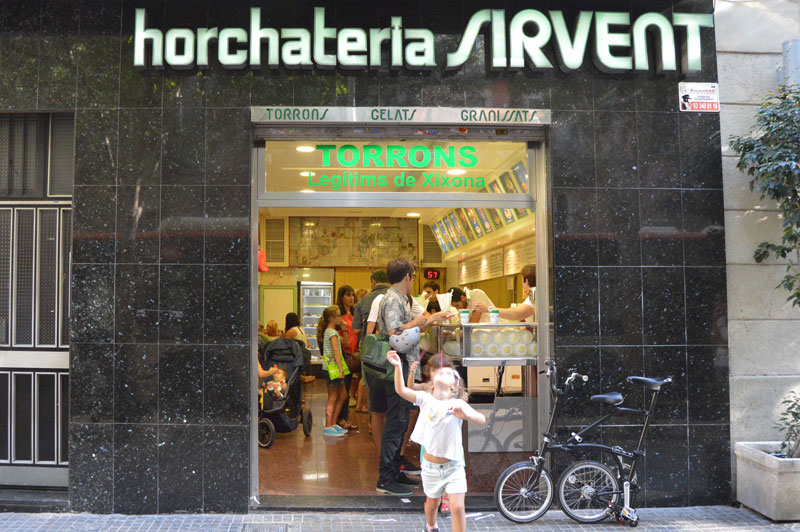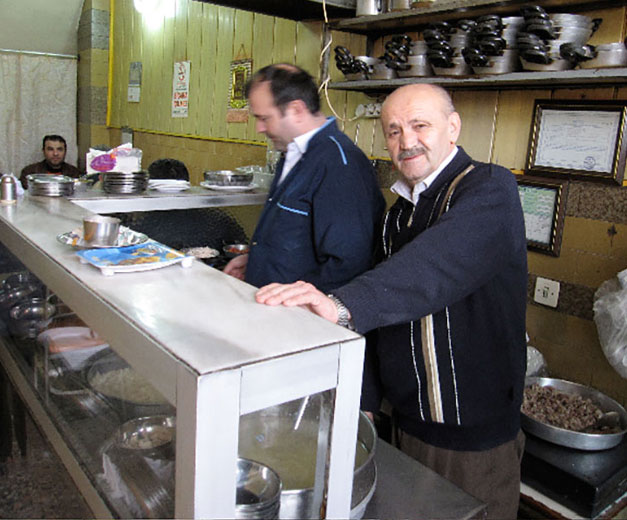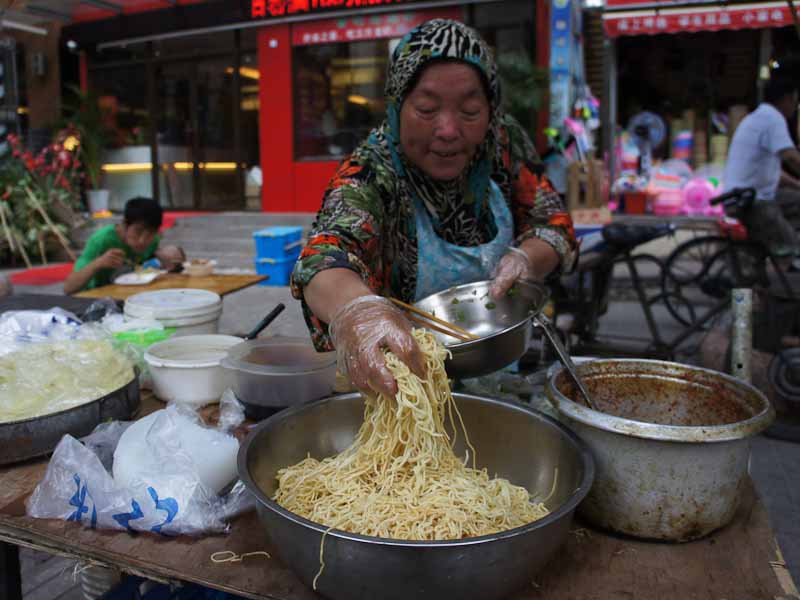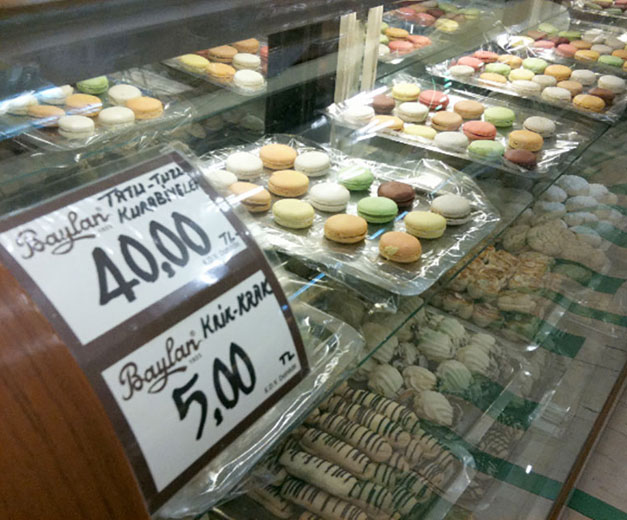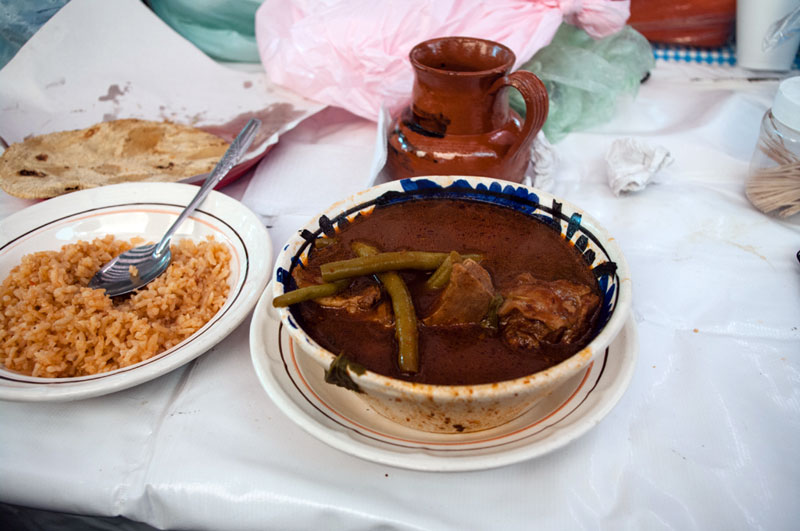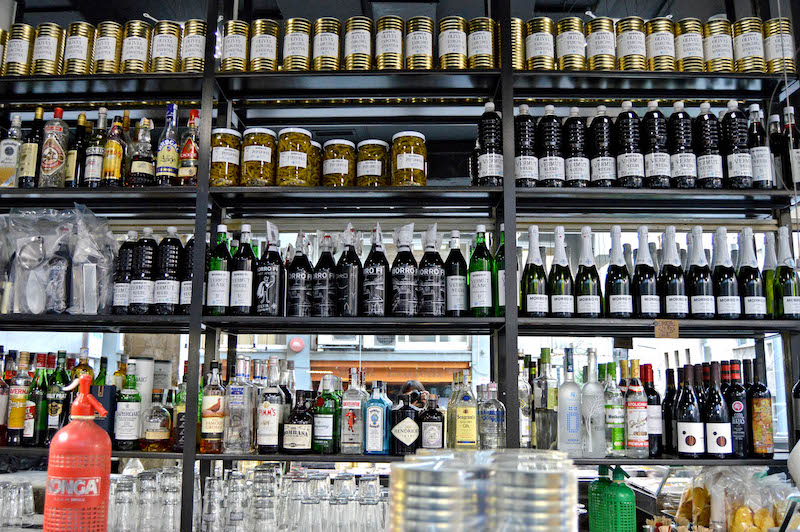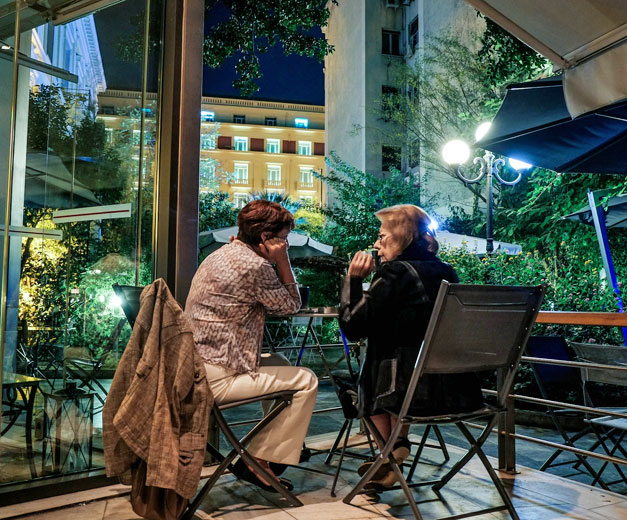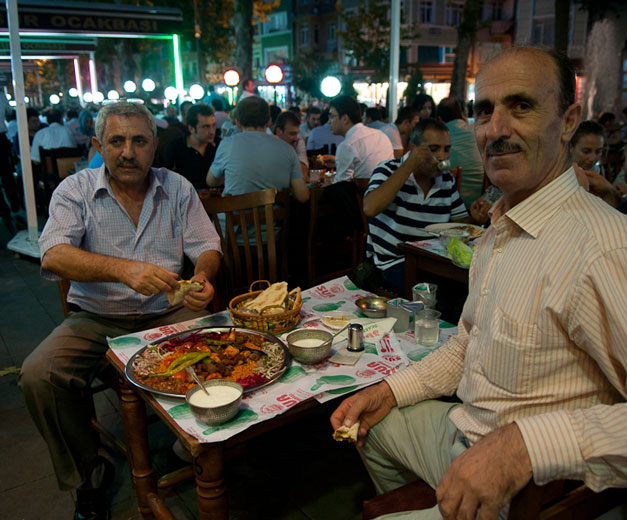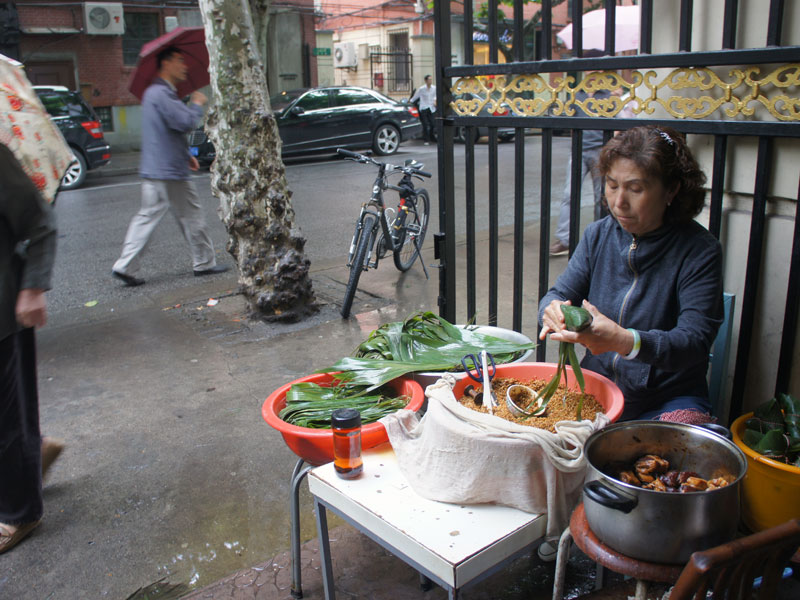We can't find the internet
Attempting to reconnect
Something went wrong!
Hang in there while we get back on track
Search results for
Mexico City
Cochinita Power: Mayan Magic
Here in Mexico City, there are many restaurantes yucatecos that serve the cooking of the Mayan states, including two of our favorites, Máare and Coox Hanal. And a few months ago, an eatery with a fresh take on Yucatecan food opened its doors in Colonia San Rafael. As its name indicates, Cochinita Power specializes in the region’s best-known dish, cochinita pibil. The traditional version consists of pork marinated in an acidic sauce made from achiote (annatto seeds) and Seville oranges, wrapped in banana leaves and roasted in an underground pit. At Cochinita Power, the meat is not roasted underground, but chef Alexis Estrada cooks the mouthwatering cochinita on the stovetop until the meat is incredibly tender and deeply imbued with all the spices and flavorings he adds to it.
Read moreIstanbul
CB Book Club: Aylin Öney Tan’s A Taste of Sun & Fire
For many (us here at Culinary Backstreets included), the city of Gaziantep is without a doubt the culinary mecca of Turkey. Located not far from Turkey’s southern border, a meeting point between the Arab Middle East and Turkish Anatolia, Gaziantep over the centuries has developed a culinary culture that is deeply rooted in the rhythm of the agricultural lands surrounding it and that is maintained with great pride and honor by the city’s cooks and food makers. Gaziantep is also the source for many of Turkish cuisine’s iconic dishes – the city’s famous baklava is without compare and its kebabs are truly works of art, the standard by which all others are measured.
Read moreMexico City
Con Sabor a Tixtla: From Guerrero, with Love
Mexican cooking is clever. With just a handful of ingredients, each region of the country has managed to create a unique cuisine that reflects local lifestyles and traditions. This fact is made abundantly and deliciously clear at Con Sabor a Tixtla, a small, family-owned restaurant in Mexico City’s hip, vibrant Roma neighborhood. Located on a quiet street not far from Mercado Medellín, the restaurant specializes in food from Guerrero, a southwestern state – home to the famous resort town of Acapulco – known for its seafood and its green pozole, a meat and hominy stew that is one of Mexico’s most iconic dishes.
Read moreShanghai
Yuyang Laozhen: Farm to Table
Shanghai’s farm country is closer than most residents imagine, especially when surrounded by the city’s seemingly endless forest of skyscrapers. But just beyond the spires is a huge, green oasis: Chongming. Somewhat smaller than Hawaii’s Kauai, this island at the mouth of the Yangtze River grows much of the municipality’s food supply. The government is pushing plans forward to develop the area with “eco-friendly” industries by 2020 but, as usual, has not provided many details on how these goals will be achieved. A stopping point for millions of migratory birds each year, the island (for now) has several wetland zones and ecological parks that are open to visitors, making it a worthwhile jaunt for those wanting to escape Shanghai’s urban jungle.
Read moreIstanbul
Hamo'nun Yeri: The Early Bird Gets the Chickpea
During our previous trips to Istanbul’s “Little Gaziantep” – where we enjoyed the special techniques of Turkey’s culinary nerve center at the excellent Hizmet Kardeşler – we were tempted by what lay across the street. It was an alluring sight scarcely seen in Istanbul: the simple yet scrumptious nohut dürüm. The wrap of chickpeas, parsley and spices nestled within a formidable section of tırnaklı ekmek flatbread is the specialty at Hamo’nun Yeri (Hamo’s Place). Run by a family with roots in the Gaziantep district of Nizip, the restaurant’s name comes from the family patriarch.
Read moreAthens
CB on the Road: A Food Lover's Guide to Andros
Some islands, Mykonos and Santorini for example, are known for their temples of gastronomy. Others, like Tinos, Milos, Syros and Sifnos, possess solid reputations for uniformly excellent tavernas. Until recently, Andros, a green anomaly in the treeless, windswept Cycladic chain, had two main attractions for tourists: a world-class modern art museum and a network of well-maintained hiking trails. You could get a decent meal after you’d seen the exhibition in Hora or trekked up to a 1,000-year-old monastery or down a river lined with water mills, but it wouldn’t be something to write home or tweet about.
Read moreBarcelona
Best Buzz: Barcelona's Top Coffee Shops, Part 1
In Spain, as in the U.S. and elsewhere – even as we hit coffee pod peak – a new multicultural generation of specialty coffee shops are discovering and sharing with their customers the best ways to experience all the special characteristics of truly great coffee. Spain’s cities share the urban Mediterranean tradition of strong short coffee, very much influenced by Italian espresso and served in small cups or glasses, with tons of sugar and perhaps also liquors (orujo or aguardiente, anís, coñac). Much of the time, the quality of this coffee could really hurt your body and soul. It’s made from cheap, low-quality Robusta beans that undergo torrefacto (toasted at 200 degrees C with sugar) – once a technique to keep flavor and increase weight but now widely regarded as a way to hide terrible qualities or to ruin any coffee. At the same time, in the countryside and in small villages, café de puchero, coffee made in a pot and filtered with a cloth, much lighter and more diluted than espresso, was always the brewing method of choice before the rise of the stovetop moka pot.
Read moreRio
Diamonds in the Touristy Rough: Makalo
The quiet neighborhood where Makalo is located, right between Syntagma and Plaka, is home to some good restaurants (such as old-fashioned Paradosiako) and even to a strip of ethnic joints located on bustling Apollonos Street. Considering the area’s proximity to some of the biggest hotels in Athens and to the ultra-touristy Plaka, however, it’s rather surprising that not many visitors have caught on to the charms of Makalo, a local hangout with a fun vibe and great Greek-style cocktails.
Read moreTokyo
Ma-Suya: Salt Mine
Japanese cuisine is often the art of quiet subtlety, and to that end, salt is one of its greatest supporters. The freshest of fish can be highlighted with a splash of the correct salt; cold sake drunk from fragrant cedar vessels is well enhanced with salt on the rim; and even tempura is frequently not dunked in sauce but instead sprinkled with salt by serious connoisseurs of fried delicacies. Salt plays a very significant role in Japanese culture and religion. It is a sign of purification. Thus most sushi restaurants mound salt on both sides of the entrance to show the place is clean and pure. Sumo wrestlers will throw salt into the ring before a match. Japanese people frequently throw salt over the entrance to their homes to purify their households. We’ve even seen people with packets of salt in their car.
Read moreBarcelona
Pintxos: Basque Bites
Oriol’s face lights up whenever a customer selects his favorite pintxo from one of the 49 different trays, beautifully displayed at Euskal Etxea, the bar where he works and the first bar in Barcelona to serve traditional Basque pintxos. One wonders how a small slice of bread topped with a chickpea fritter, jamón serrano and romesco sauce spiked with a toothpick that costs just €1.95 can make someone so happy. We try one and we immediately see why.
Read moreTbilisi
Cafe Littera: Don't Call It Fusion
We are sitting under the tonic canopy of an enormous pine tree in a hidden Tbilisi garden, licking our lips over menu items that are neither European nor Georgian. When our dining companion informs us she will not share her trout tartare with adjika (highly concentrated spicy red pepper paste), we realize there will be no plate-dipping tonight. Just as we settle on our main courses, a woman in a blue chef’s jacket comes up to our table, beaming bonhomie, and asks if she can help us in any way. This is Tekuna Gachechiladze, the blue-eyed Tbilisi chef dedicated to changing the way Georgians understand their food culture. We are sitting at her latest culinary venture, Cafe Littera.
Read moreRio
Primeira Pá: Chinese, Made in Brazil
For a country of Brazil’s size (pop. 190 million), the number of foreigners in the country is pretty miniscule. Less than 1 percent of the country’s residents are foreign-born; the top countries of origin for those foreigners are the U.S., Japan and Paraguay. (By comparison, about 13 percent of the U.S. population of 319 million is foreign-born.)
Read moreIstanbul
Hizmet Kardeşler: Little Gaziantep in Istanbul
The T1 tramway route passes by virtually all of Istanbul’s most well-known sights. Crossing the Galata Bridge and weaving through the Old City, the T1 practically rubs up against the Hagia Sophia, Topkapı Palace, the Grand Bazaar and other famous attractions, ensuring that most foreign visitors to the city will ride this tram within a five-stop radius. But after the T1 rumbles past the old city walls, it snakes its way northeast through a dense patch of working-class districts usually ignored by tourists. Dreary on the outside though they may look, many of these neighborhoods are laced with off-the-beaten-path charm and culinary delights hidden in plain view.
Read moreMexico City
Fonda Mi Lupita: Holy Mole
We’ve written about mole before, but it’s possible that there aren’t enough words to spill on such a complex dish – probably the most complex in all of Mexican cuisine. Mole has become part of the mainstream culinary scene in Mexico, and many restaurants now sell it every day of the year. However, very few places are mole-only eateries, and even fewer have a mole great enough to have sustained business for decades. One of our favorite eateries, Fonda Mi Lupita, a small fonda in the Centro Histórico that started making mole in 1957, holds that rare distinction.
Read moreElsewhere
Kalky's: Fried Fish Paradise
Fresh fish caught daily in the icy Atlantic Ocean – this is the key to the longtime success of Kalky’s, the original fish and chips restaurant in the seaside village of Kalk Bay, one of South Africa’s oldest working harbors. In the summer of 1996, the Rosslind family started this small takeout café serving satisfying fried hake (cod) and snoek (mackerel), with fish supplied by the local fishermen of Cape Town’s Kalk Bay. Kalky’s size and menu have since grown, reflecting the harbor’s rich cultural and nautical history. But it remains a no-frills, no-fuss seafood spot, where utensils are optional and cash is king.
Read moreBarcelona
Country Dining: The Catalan Masía
As in many other rural parts of Europe, the Catalonian countryside is dotted with large, old farmhouses, legacies of feudalism that have since been converted into hotels, bed-and-breakfasts and restaurants. The origins of these masías, as they’re known in Catalan, go back to the 11th century, but it was not until the end of feudalism in the 16th century that the former serfs turned masías into their own self-run farm holdings and homes. The buildings that survive today may be of a more recent vintage, built perhaps a century ago, sometimes older. Masías were usually named after the family who owned them; “Can Josep,” for example, means “house of Josep.”
Read moreElsewhere
Breakfast in Beirut, Part 1: Abu Hassan
Breakfast in Beirut can be a lavish affair and would make even the Ottoman sultans of old jealous. Although Beirut is known as a 24-hour city, with a lively nightlife scene fused with an endless amount of social gatherings, people still find time to enjoy a long morning meal with loved ones on weekend mornings. The ingredients of Lebanese breakfast foods are quite simple – chickpeas, yogurt, eggs, tahini, lemon juice, ground meat, bread and olive oil – and are assembled in a number of ways that make breakfast something not to be missed while in Beirut.
Read moreMexico City
Ask CB: What Are Aguas Frescas?
Dear Culinary Backstreets, I’ve heard about drinks in Mexico called “aguas frescas,” but what exactly are they? Visitors to Mexico are sure to encounter aguas frescas, a popular category of drinks that are ubiquitous at food stands and eateries around the country. These colorful beverages, whose name literally means “fresh waters,” come in a variety of different flavors depending on the main ingredient, but generally all are made by mixing a fruit juice with water and sugar.
Read moreIstanbul
Kelle: Face Off
Don’t people just love to fight about food? Punch-ups over which city makes the best pizza, brawls about what’s the right way to barbecue. Louis and Ella nearly called the whole thing off over the pronunciation of the word “tomato.” In this pugilistic spirit, we took our place at a couple of stools at our favorite back of the fish market corner bar, Asmaaltı, from which to call one of the great barroom debates of these parts: Is a sheep’s head, or kelle, more tasty when boiled and served chilled or roasted and served hot?
Read moreShanghai
The Shanghai Soup Dumpling Index: Can You Measure Good Taste?
Back in 2012 when Culinary Backstreets still had that new car smell, we wrote our first article on xiaolongbao. The investigative report detailed the bun’s regional variations – Shanghai versus Nanjing – and called out our two favorite places to eat each city’s specialty soup dumplings. Understanding, appreciating and loving these local specialties is a part of life for residents of pork-obsessed Shanghai. Arguing the merits of different restaurants’ xiaolongbao is a citywide pastime for both locals and expats alike, but one man has taken the fascination further than the rest of us combined.
Read moreTokyo
Gontran Cherrier Shibuya: Sweet Dreams
It’s a common fantasy: Accidentally locked in a bakery, forgotten overnight, we quickly eat everything in sight and fall into a sugary, carb-filled dream of sweet-spun bliss. Sequestered away where nobody will find us until morning, we wake from time to time and continue to eat cakes until we sleep again. Short of that happening in this lifetime, we frequently daydream of walking the aisles of bakeries, latte in hand as we pull pain au chocolat and sticky buns from racks, consuming everything in a hurried rush before we’re asked to leave.
Read moreRio
Prana Cozinha Vegetariana: Move Over, Churrasco
We hear it every time we bring up the V-word: “But it’s impossible to be a vegetarian in Rio!” Nonsense. Not only is it possible to eat an earthy diet here in Rio, it’s getting so trendy that carnivorous cariocas are increasingly forgoing their weekend churrasco (grilled meat on a stick) for the kaleidoscope of couve (collard greens), cogumelos (mushrooms), tofu and all of its soy brethren. (Remember: Brazil is a soy powerhouse, one reason why China surpassed the U.S. to become its largest trading partner.)
Read moreAthens
Dexameni: From the Womb to the Tomb
The blackboard hanging outside Dexameni’s cramped kitchen reads, “Kindergarten-Bar-Nursing Home,” the title jokingly bestowed upon the café by the eminent novelist and poet Alexandros Papadiamantis. He was among the literati who made Dexameni their regular hangout shortly after it opened in the early 1900s – so regular that the place ended up serving as a home-away-from-home for all stages of life.
Read moreIstanbul
CB on the Road: Off the Beaten Path on Turkey's Turquoise Coast
Along the southwestern coast of Turkey, the vibrant blue waters of the Mediterranean crash against dry, rocky mountains jutting from the water’s edge. For centuries, pilgrims and adventurers alike have scrabbled over the unforgiving terrain between Fethiye and Antalya known as the Lycian Way. Ruins dating back to Greek and Roman times nestle between the scrubby trees and undergrowth, melding with the landscape and painting a picture of the life that has always dotted the shore. The Turquoise Coast is a popular place to visit in the summer, with massive sand beaches and countless pansiyons catering to every type of tourist. While most people visit this region for its stunning vistas and beaches, it has exceptional food if you know where to look.
Read moreTokyo
Daruma: Good Luck Ramen
Almost 40 years ago Daruma opened its doors near Aoyama University, feeding the hungry students who flocked there, along with many neighbors and workers from the nearby office buildings. The prices were reasonable and the ramen was top class. Everyone came for the original recipe: Japanese-style ramen, with fresh house-made noodles and a pungently addictive broth of pork, chicken legs and vegetables, spiked with shoyu (soy sauce). Daruma opened as just a great place to fill your stomach with good food.
Read moreShanghai
Sleight of Hand: Lanzhou, Henan and DIY Noodles
Wandering around Shanghai’s quieter streets, you may often hear a thump thump thwack! ringing out from a streetside café. If you’re lucky, it means someone is pulling noodles fresh to order, and if you’re even luckier, you’ll happen to be hungry enough to enjoy a bowl.
Read moreIstanbul
Cuma Usta: Anatolian Snow Cone
Standing behind the counter at his small bici bici shop in Gökalp Mahallesi, a neighborhood in the Zeytinburnu district of Istanbul, Cuma Usta recalls the first time he headed up into the mountains with his uncles in search of wild ice, one of the key ingredients in this Turkish snow cone treat sold from street carts throughout southern Turkey. His uncles had gone up in the winter and cut large slabs of ice from the mountaintop, wrapped it in old blankets and hauled it off with a donkey to a nearby cave. In July, with young Cuma – just being introduced to the ways of bici bici – in tow, they headed back to the cave to collect the ice. It took a couple of hours by car, as he recalled, and the ride back to Adana, vehicle loaded with the frozen bounty, was nice and chilly. Then they’d use that ice to make the summertime street food favorite bici bici (pronounced like the disco-era band of brothers from Australia) and sell it from pushcarts. According to tradition, a bici bici master is, firstly, a harvester of ice.
Read moreBarcelona
Catalan Ice Cream: The Real Scoop
As you might expect from a city whose weather forecast tends to be sunny, Barcelona has plenty of excellent ice cream options, even as summer fades into fall. And, sure, like most of the world’s food-loving metropolises, this town has its share of internationally loved, Italian-style gelaterias – many even run by real, live Italians.
Read moreMexico City
Café de Raíz: Veracruz in the D.F.
The cuisine of Mexico City has long been influenced not only by waves of international immigrants but also by regional cooking from around the country. In the mid-20th century particularly, droves of workers and their families, lured by economic opportunities, arrived in the Distrito Federal from every corner of Mexico, bringing their local customs and food traditions with them and greatly enriching both the city’s culture and its culinary scene.
Read moreIstanbul
Kısmet Muhallebicisi: Funky Chicken
Ali Bey, the owner of a cubby-sized restaurant in Küçük Pazarı called Kısmet, sounded a bit like Bubba Gump listing the items on his menu: “We've got chicken soup, fried chicken gizzards, shredded chicken breast, dark chicken meat too, chicken and rice, chicken with onions and peppers, and chicken breast pudding for something sweet.”
Read moreAthens
Weathering the Storm: Athens Eateries in a Time of Crisis
With the banks closed for almost two weeks and Greece’s position in the eurozone the subject of heated debate and endless negotiations for the past several months, we wondered how some of our favorite restaurants were coping. Greeks had voted NO to austerity the previous Sunday (July 5), but did this mean they were spending their spare cash on staples for harder times and going out only to take part in demonstrations or stand in ATM queues?
Read moreBarcelona
Mercat del Ninot: Rebound Market
El Mercat del Ninot opened way back in 1894, but recent renovations have breathed new life into this L’Eixample market. From time to time, the local government has updated noucentistes (19th-century) municipal markets in Barcelona, keeping the essence of the buildings but bringing them up to speed with current needs and trends. The Mercat de la Llibertat in Gràcia and Mercat de Santa Caterina in Born have received their facelifts, and the amazing Mercat de Sant Antoni is expected to open in 2016 after more than six years of construction.
Read moreTokyo
Tokyo: State of the Stomach
Several years ago, when the Michelin Guide decided to swoop into Japan and rate its cuisine, restaurateurs were slightly shell-shocked to learn that Japan came away with almost as many highly regarded establishments as France. (And in fact, Tokyo wound up with two more three-star restaurants than Paris.) Then, in 2013, UNESCO put washoku (Japanese cuisine) on its Intangible Cultural Heritage List, alongside such icons as the Argentine tango, Turkish coffee and falconry.
Read moreShanghai
Muslim Market: Western Exposure
Food lovers mourned the loss of Shanghai’s Muslim market when it packed up its stalls a couple of years back, but the closure wasn’t too unexpected. Street food is always in a state of flux in Shanghai, and add to that the ethnic tensions that have developed between the Chinese majority Han and the Muslim minorities that butchered whole lambs outside Putuo’s Huxi Mosque each Friday, and it seemed like a matter of time before the weekly event was closed. The government ostensibly blamed neighbor complaints (the bazaar seemed to have outgrown the sidewalks, interfering with traffic and sending smoke from the grills into the residential areas), and vendors were abruptly told to pack up.
Read moreMexico City
Marisquería El Caguamo: Downtown Seafood Paradise
A foodie friend of ours took us to El Caguamo – aka K-guamo – for the first time a few years ago, promising us that this was the best marisquería (seafood restaurant) in the city. And since then, it has become one of our favorite downtown stops. For almost 40 years, the Tamariz family has been selling tasty shellfish and seafood on the sidewalk of Ayuntamiento Street, just a couple of blocks away from San Juan market in the heart of Mexico City.
Read moreIstanbul
Baylan Pastanesi: A Slice of History
The roaring '20s: Flappers in the Pera Palas Hotel were dancing the can-can, Art Deco was all the rage, the Turkish Republic was born. Hope, progress and newness double-stepped to the beat of Kemal Atatürk’s drum. This was the backdrop to which two Istanbul bakers, Filip and Yorgi, opened a whimsical chapter in the culinary story of the city
Read moreBarcelona
CB on the Road: The Catalan Stew Masters of Juneda
Upon the hot and dry plains of Les Garrigues, two irrigation canals cut through an agricultural expanse, diverging first from the ample Segre River, which runs through the center of the city of Lleida, before subdividing again, their meandering channels reaching farther and farther into an otherwise parched plateau. These life-giving tributaries are collectively known as the Canal d’Urgell. Les Garrigues, a region of the Catalan province of Lleida, is a fertile green splotch on an otherwise arid landscape 150 kilometers inland from Barcelona. The irrigation of this region, first conceptualized by the Moors in the 13th century but carried out on a grand scale in the late 1700s, has enabled the cultivation and nurturing of farmland, where a crop of prized arbequina olives and fragrant almond trees now stretches toward the horizon.
Read moreTbilisi
Sarcho: Museum-Quality Eats in Old Tbilisi
In a land with no breakfast culture to speak of, a couple slices of khachapuri and a cup of tea or coffee are all it takes to fuel you up until suppertime. If you need a snack to carry you over, you grab a pie at any one of the hundreds of khachapuri stands in Tbilisi, and no supra – feast – is complete without an “Imeretian” or “Megrelian” pie for every three people at the table.
Read moreMexico City
Señora Ema: The Wild Brunch
Update: This spot is sadly no longer open. The tianguis, or street market, has been an essential part of Mexican culture since pre-Hispanic times. In Mexico City, every neighborhood has at least one weekly tianguis, most selling produce, fish, meat and household goods, so families can buy all they need for the week in a single place. All of these markets, large or small, have one thing in common: an abundance of street food stands. Many of these vendors move around the city with the markets, and some have become so well-loved that neighborhood residents eagerly await the day of their local tianguis so they can enjoy tasty food served streetside.
Read moreRio
Aconchego Carioca: Pretension-Free Zone
The Praça da Bandeira, an area of Rio that until recent years was mostly known for prostitution and cheap inner-city housing, is rapidly changing. Lying in the shadow of the massive Maracanã Stadium – built for the 1950 World Cup and the planned location of the opening ceremony of the 2016 Summer Olympics – it is alive with new construction and pedestrian traffic, which are changing the tired face of this historical but underappreciated neighborhood. And sitting snugly in the midst of this new buzz is Aconchego Carioca, a restaurant and bar with one of the best beer menus in Rio.
Read moreElsewhere
Café Ganesh: New South Africa (on a Plate)
In the late 1980s, Anthony Mlungisi Baker lived in Spain and other parts of Europe to dodge the military draft in South Africa. On February 11, 1990, the release of Nelson Mandela signaled the end of the apartheid regime and time for Baker to return home and become part of a new creative transformation. With a love for entertaining and cooking for his friends, Baker saw a gap in the “New South African” market for something different in the bohemian Observatory district (known as Obz to locals). The result was Café Ganesh, which opened its doors on November 10, 1990, and has since gone on to become a neighborhood institution.
Read moreBarcelona
¡Salud!: Barcelona's Top 5 Places for Vermouth
Why are you seeing colorful, 1960s-era carbonated water siphons everywhere in Barcelona? Because they’re the symbol of our beloved vermut ritual. The phrase hacer el vermut (literally “to do the vermouth”) in Spain has for decades described not only that delicious beverage, but also any kind of pre-lunch aperitif. But since the end of the 19th century in Barcelona, the vermut ritual – a fresh drink accompanied by tapas composed usually of preserved food, cold cuts, cured or marinated fish or seafood – has been a way to bring people together before meals. Perhaps no one is more responsible for vermouth’s popularity here than Flaminio Mezzalama, the Italian Martini & Rossi representative in Spain, who in the first decade of the 20th century opened two beautiful Art Nouveau vermouth bars, which became hugely popular. Mezzalama died in Torino in 1911, but the fame of vermouth in Catalonia only grew, with local investors putting their money into production of Catalan vermut.
Read moreRio
CB on the Road: Northeastern Exposure in João Pessoa
Chat up the older residents of a Rio favela and you’re likely to start hearing romantic stories about Brazil’s northeast: those colorful cajú and mangaba fruit trees, the clear turquoise ocean, the folksy and upbeat forró music, chewy tapioca sandwiches and cakes. Brazilians call that saudades – a longing for something lost, which may or may not exist in the form one dreamily remembers it. These are the pleasant memories many northeastern immigrants hold amidst the urban hustle of crowded Rio de Janeiro, where a working-class Brazilian knows the beach exists but easily lives a hot two-hour bus ride away from it.
Read moreAthens
Green Scene: Athenian Gardens of Eating (and Drinking)
In terms of greenness, Athens doesn’t even come close to other European capitals, with their verdant parks and blossoming gardens. The truth is, modern urban development has not been particularly gentle with this city. Numerous concrete buildings, along with poor road design, hem in inhabitants and visitors with featureless views.
Read moreMexico City
CB on the Road: Seafood (and Hard Times) in Veracruz
Sitting on the boardwalk of Veracruz, about five or six hours east of Mexico City, we watch the blinking lights of shrimp and fish boats in the farthest distance, knowing our next dinner is on its way. A day before, arriving from the bus, all we wanted was especially satisfying seafood, and the hunt brought us downtown, which, in the past, has always provided. Veracruz is a warm harbor, embracing all comers and proposing excellent food and endless dancing into the night on the city’s street corners. Or that’s how we remembered it.
Read moreIstanbul
Ramadan's Iftar: The Break Fast of Champions
Think of Ramadan, which just began in many parts of the world, as a kind of monthlong biathlon that consists of an all-day race to beat back the hunger and thirst of fasting, followed by an all-night marathon of eating and drinking in order to fortify the body for the next day’s fast. In recent years in Turkey, iftar, the traditional break fast meal that used to mostly consist of some dates and a freshly baked round of Ramadan pide, has started to become an increasingly trendy affair, with ministers, businessmen and regular people trying to make an impression by hosting ever more lavish meals.
Read moreShanghai
Zongzi: Dragon Boat Delights
In typical Shanghai fashion, good things come to those willing to stand in the longest lines, or to pre-book the farthest in advance. We’ve seen the queue for braised duck at Guang Ming Cun swell to several hours long during the Chinese New Year, and A Da's scallion pancakes require a minimum hourlong wait on most days, yet we had never expected the same for the humble zòngzi (粽子).
Read moreIstanbul
CB on the Road: Deniz Börek Salonu in Edirne
Edirne has more meat to offer beyond the glistening liver that bears its name. Deniz Börek Salonu has crowned the top of Saraçlar Caddesi since 1986. Every morning, lines of salivating citizens hurry to work with crunchy poğaças or sit down to enjoy steaming heaps of stuffed pastry. While there are many börek places in Edirne, few are able to produce the consistently delicious product that Deniz is known for. Imagine, if you will, savory labyrinthine baklava sheets of golden-brown pastry, stuffed like sausages. The bready tubes are baked, set on a hot table in a window, then viciously chopped into strips with a knife that looks like it should belong to a 19th-century werewolf hunter. Common fare at börek places are kıymalı (minced meat), peynirli (salty white cheese), patatesli (potatoes) and ıspanaklı (spinach).
Read moreMexico City
Best Buzz: Mexico City's Top 5 Coffee Shops
Like other cities around the world, Mexico City has been flooded with big-name chain coffee shops that charge exorbitant prices for a cup of bad coffee. Fortunately, D.F. is a city of contrasts, where good taste in coffee still exists. We set out to find the best coffee shops in town and were surprised by what we found. Our first stop was one coffee shop we have been visiting for several years now, Café Triana, inside Mercado San Juan, the city’s first gourmet stop par excellence. Marilu and Pablo Arana started selling coffee from Veracruz, a city on the Gulf of Mexico with a Caribbean feel, in the aisles of the market until they got the chance to get a booth and start their own coffee shop. Their establishment has since been featured in many national and international media outlets.
Read more













